What is the name of small cabbage?
Miniature tomatoes and cucumbers have long become familiar, but cabbage the size of a walnut is an exotic product for consumers. The vegetable appears in markets infrequently and gardeners look at it with interest. In the article we will tell you what cabbage in the form of small heads of cabbage is called, everything about the varieties and characteristics of the crop, which is already grown in Russia.
What is the name of small cabbage?
Cabbage, the forks of which look like savoy or white cabbage in miniature, is called Brussels. Sometimes the unofficial German name rosenkol is found.
Reference. It is generally accepted that the little cabbage got its name in honor of the city where it was created. In fact, it appeared in 1655 in Flanders, in the commune of Saint-Gilles, which later became part of the Brussels-Capital District. By that time, the vegetable began to gain popularity and had already spread from Brussels throughout Europe.
What are Brussels sprouts and what do they look like?

Brussels sprouts are considered a type of cabbage. It was bred artificially on the basis of kale, so it is not found in the wild.
The plant is biennial. In the first year, it forms a thick stem with a height of 20 cm to 1 m. The leaves on elongated (15-35 cm), powerful cuttings are located along the entire length of the stem, and at its top are collected in a rosette.
The leaf blades are round in shape, smooth or spoon-shaped, with straight or wavy edges. Covered with a thin waxy coating. The surface is slightly bubbly, the venation is clearly visible.Leaf width – 18-32 cm, length – 18-40 cm. Color depends on the variety. These can be different shades of green and even purple.
When the stem grows to its maximum height, miniature cabbage heads from 20 to 100 pieces begin to form in the axils of the leaves (at the base of the petioles). on one plant. Most often they are dense, but there are varieties with loose heads.
They are divided into 3 categories based on size:
- small – up to 2.5 cm in diameter;
- medium - from 2.5 to 3.5 cm;
- large - the diameter of the fork is more than 3.5 cm.
The shape of the heads can be round or ovoid. The weight of one head of cabbage is 10-25 g. Early varieties ripen by the middle of the season, and Late-ripening cabbage is harvested closer to the beginning of winter. The taste is often neutral, sometimes sweetish, with a bitter or nutty aftertaste.
Reference. Brussels sprouts ripen gradually - from the bottom of the stem to the top, so the heads of cabbage are cut in several stages.
From the second year, the plant produces flower stalks and produces seeds. Small yellow flowers are collected in a brush. Fruits in the form of pods. The seeds are round, dense, dark brown, up to 2 mm in diameter. The weight of 250 seeds is about 1 g. Germination persists for 5 years.
Photo: what Brussels sprouts look like
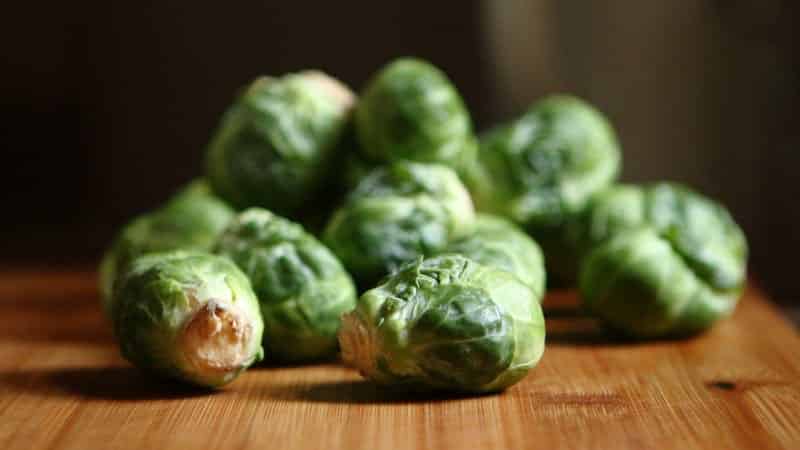
Where do Brussels sprouts grow?
The culture is especially popular among farmers in Western Europe. It is also widely grown in Turkey, the USA, and Canada.
Brussels sprouts were brought to Russia in the mid-19th century, but they remained unnoticed for a long time. Perhaps because the old varieties were not frost-resistant. Over time, these figures have improved significantly. Now small cabbage is grown in private farms throughout Russia, and in the central regions it is cultivated on a small industrial scale.
The vegetable grows best in areas with a temperate climate and long, warm autumns. Suitable temperature range is +18…25°C. The average frost resistance is higher than that of late-ripening white cabbage. Short-term frosts down to -10°C pass without consequences. The crop tolerates extreme heat less well - it begins to bear fruit later, and the quality of the product decreases.
Plant only in well-lit areas, in acidic or neutral soil with a lot of organic matter. They are grown in greenhouses and in open ground, by seedlings or through direct sowing.
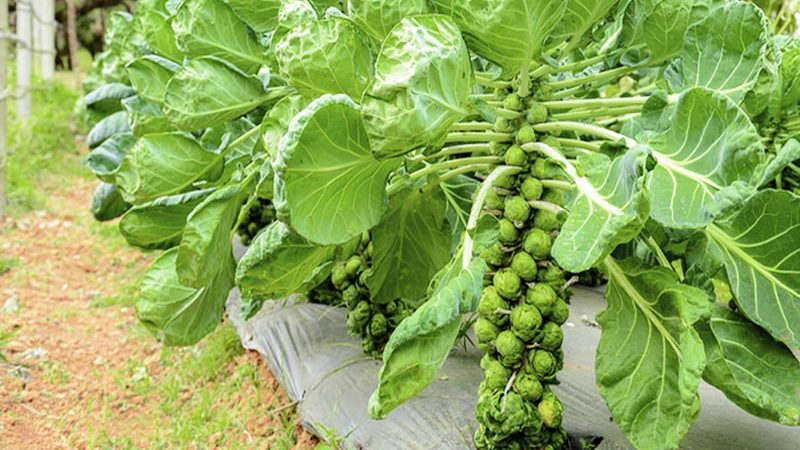
All about Brussels sprouts varieties
The varieties and hybrids that exist in Russia are included in the State Register of the Russian Federation and are grown in all climatic zones. When choosing, you should pay attention to the length of the growing season and the ability of the crop to reproduce. This will help you decide on the growing method and calculate the economic benefits.
Selection by method of obtaining seeds
Features of varieties and hybrids:
- Varieties. The arrangement of heads on the stem is sparse or medium dense. They are larger and have a distinct taste. They ripen in stages, and the growing season lasts longer. Seeds collected in the second year will retain all the varietal characteristics of the mother bush. In Russia there are varieties of domestic, Czech and American selection.
- Hybrids. They are designated F1. This means that the culture will retain its characteristics only in the first generation, so collecting seeds is unproductive. Every season they buy new seed. But hybrid cabbage is hardier than varietal cabbage, produces high yields, and the fruits ripen simultaneously and much faster. The stems of this type of cabbage are lower, the arrangement of forks is dense. The hybrids of Dutch selection are considered the best.
This is interesting:
Top best recipes for Brussels sprouts that are eaten instantly
The most delicious recipes for pickled Brussels sprouts for the winter
According to ripening period
Varieties and hybrids are divided into 3 groups:
- early - ripen in 100-150 days, the vegetable is not intended for storage;
- mid-ripening – growing season 150-180 days, fruits of universal use;
- late - ripening time 180-200 days, such cabbage is stored 3-4 months.
Small cabbage will ripen fastest in the south (in the Crimea, the Caucasus, and the Krasnodar Territory). A little later - in the central part of Russia, and the longest ripening - in Siberia and the Far East. Therefore, it is better to plant late varieties in the southern regions, mid-season varieties in the central regions, and early varieties in the northern regions.
Despite the weak mass interest in Brussels sprouts, dozens of different varieties are already successfully grown in Russia. The manufacturer indicates the characteristics on the bag of seeds.
Attention! The ripening dates stated for varieties and hybrids may be delayed due to bad weather.
The most productive Brussels sprouts
These are varieties with large heads and dense arrangement of heads on the stem.
Superior Long Island
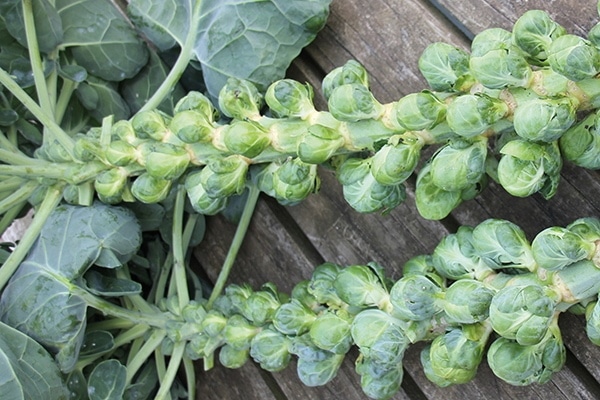
American variety. Early ripening, ripens in 90-115 days. The bush is compact, strong, about 80 cm high. The leaves are slightly bubbly, grayish-green in color. The forks are dense, in the shape of a short oval with a diameter of 3-5 cm, weighing 15-20 g. Up to 100 pieces are formed on the stem. It has a pleasant, sweetish taste. Winter hardiness down to -12°C. Tolerates heat and drought well. Productivity – 3-4 kg/m².
Franklin F1
Early maturing hybrid of Dutch selection. Ripening period is 120-128 days. Bush 60-80 cm high. Leaves are medium-sized, bubbly, bright green, with a slight waxy coating.The forks are round, dense, large, up to 70 pieces on the stem, densely located. The hybrid is immune to Fusarium wilt. Productivity – 3 kg/m².
Diamond F1
Dutch hybrid of late ripening. The growing season is about 130-140 days. Stem up to 70 cm in height. The socket is half raised. The leaves are dark green and bubbly. Waxy coating of medium intensity. The forks are obovate, bluish-green in color, weighing 20 g. There are 30-60 pieces on one plant. The taste is soft, with hints of nuts. Good resistance to major crop diseases. Productivity – up to 3 kg/m².
Popular early ripening hybrids and varieties
Suitable for northern regions with short summers. This is a vegetable for fresh table and heat treatment. Can be frozen and canned.
Dolmik F1
Hybrid of Dutch selection. Ripens in 150 days. Bushes 50-70 cm high. Leaves are gray-green, spoon-shaped with medium bubbles. The forks are round, very dense, juicy green in color, weighing about 17 g. Medium density. The yield is within 1.7-2.5 kg/m².
Rosella
German variety with a growing season of 160 days. A bush with large, curved leaves, up to 1 m in height. Cabbage heads are medium dense, oval in shape, bright green, weighing 13 g. The taste is neutral. Productivity – 1.1-1.7 kg/m².
Diablo F1
Dutch hybrid. Ripens in 155 days. Stem up to 80 cm. Leaves are juicy green, bubbly, medium in size. The forks are round, dense, 15-18 g each. Each bush forms up to 55 heads weighing 9 g. Productivity - 2.1 kg/m².
Mid-season varieties
It is more practical to plant in the central part of Russia. This cabbage is suitable for processing and short-term fresh storage (for up to 2 months).
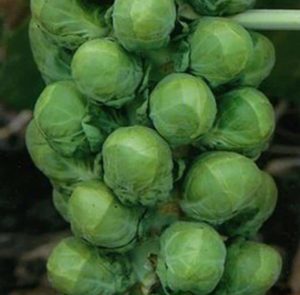
Casio
Variety from the Czech Republic. Ripening period is 185 days. The bush grows up to 125 cm. The forks are dense, with a bluish tint, 2-3 cm in diameter. The weight of the fruit is 10-11 g. There are 70 heads on the stem. Productivity – 2 kg/m².
Constellation F1
Domestic hybrid. Ripens in about 170 days. Bush up to 80 cm high. Medium-density forks, large, weighing 20 g. Widely located, 30-40 pcs. on the stem. From 1 sq. m collect 2 kg.
Funny company
Domestic selection variety. The growing season is 140 days. It has high dietary properties. The bush is medium-sized, strong. The forks are round, dark green with a purple tint, weighing 10-12 g, ripen evenly. Productivity is about 2 kg/m².
Late varieties
Grown in the southern regions. They ripen in December and, in the long, warm autumn, have time to reach their full potential. Forks are processed or stored fresh for about 4 months.
Gruninger
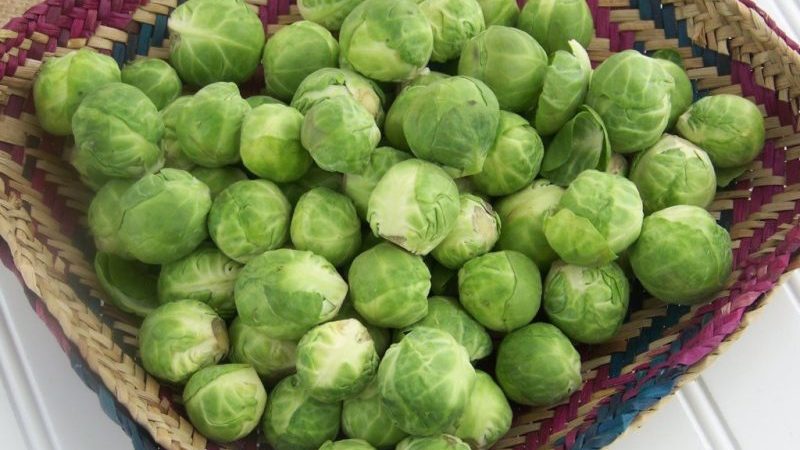
German variety. Ripens in 170 days. The bush is powerful, hardy, 60-70 cm in height. The forks are round, dense, 3-4 cm in diameter, weighing 10-15 g. They are distinguished by a high protein content and an unusual greenish-orange color. Up to 80 pieces are formed on the stem. Productivity – 3 kg/m².
Sapphire
Domestic selection variety. The growing season is 180 days. The stem is about 70 cm. Forms 45-60 forks. The heads are dense, 3-5 cm in size, weighing 8-14 g. Excellent taste characteristics with a pleasant nutty hue. Productivity – 2.5 kg/m².
Curl
Czech variety with a ripening period of 170-180 days. Bush 80-90 cm in height. The leaves are oval, with a wrinkled surface. Each plant has up to 35 forks, 10-15 g each. The heads are round, 4-5 cm in diameter. Productivity is 2.4 kg/m².
Red Brussels sprouts
The shade of the variety is influenced by the content of anthocyanin and carotene.The color of the heads of cabbage can be purple, beetroot or burgundy. They have a spicy taste and do not lose color after heat treatment. Let's look at red types of Brussels sprouts with names and photos.
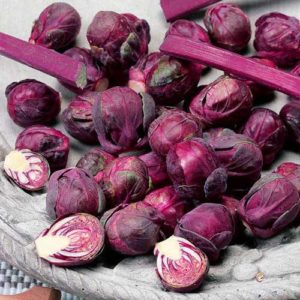
Garnet bracelet F1
Russian mid-season hybrid. The leaves are dark green with burgundy veins. The stem is 60-70 cm high. The forks are purple, oval, weighing up to 10 g. There are 30-40 pieces on the stem. Productivity – 1.5 kg/m².
Bunch of grapes
Late-ripening, domestic variety. Ripens in 160-180 days. Each stem has 30-45 round, dense forks of a reddish-beetroot color, weighing up to 15 g. Very tasty cabbage, tender and sweetish. Productivity is about 3 kg/m².
Conclusion
The main feature of Brussels sprouts is their miniature forks. But this is not a dwarf variety, but a variety of ordinary cabbage, which was obtained artificially. The culture develops best in a temperate climate. It ripens slowly, so in regions with short summers only early ripening varieties are planted.